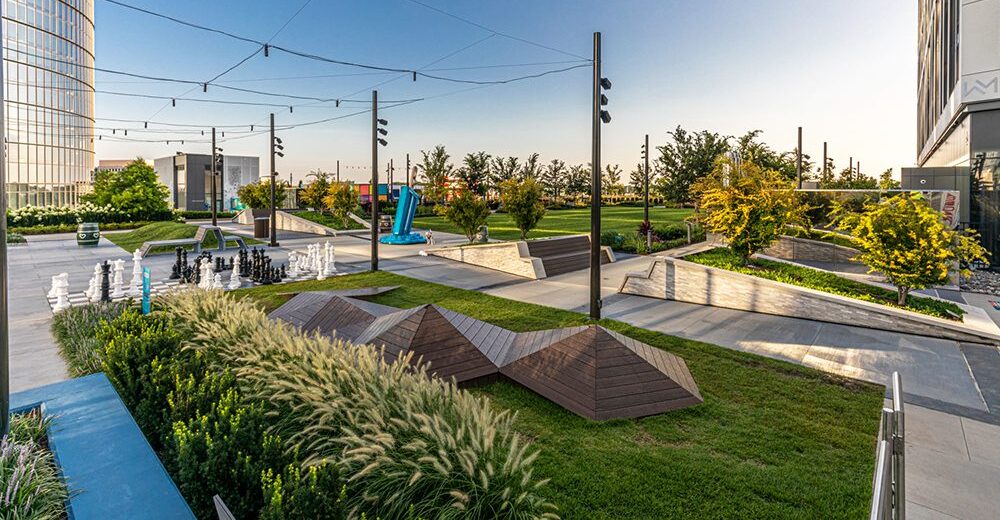
 By Ronnie Few, Business Developer
By Ronnie Few, Business Developer
We’ve all had the common experience of being on a newly constructed site—whether it’s a new office building, a master-planned community, or a new park. The site looks sharp with fresh plantings and mulch, newly laid sod, inviting walkways or patios, and decorative accents like a fountain, sculpture, or seating areas. For those of us in the landscape construction division, we know that the work to bring this project to fruition began months or even years earlier. But for those of you who work on the maintenance side of our business, or for those reading this who are our customers, you may not be as familiar with the steps and team effort it takes to make these projects a reality. Join us as we walk through the life cycle of a typical commercial construction project.
Every development begins as an idea. An owner/developer contracts an architect to turn that idea into plans. Those plans are then handed off to their development team or general contractors for pricing and logistics to build the idea. Those teams then engage subcontractors to help with this process. Together, all parties involved work to overcome budget constraints and logistics through drawing revisions and negotiations. These hurdles must all be cleared before the first shovel can ever hit the ground. Once contracts are in place and everyone is on the same page, ground is broken, and the manual work begins to start building. The planning process for a new project can take several months or even years.
You may be asking yourself, at what point does Ruppert get involved in this process?
We are typically bidding a project one to two years before the project is slated to begin. The projects that are in the pipeline—essentially contracted but not yet completed—is what we call backlog. Once we’ve been contracted to do the work, our goal is to get involved at the very beginning of the project. When an idea becomes a reality, we want Ruppert Landscape to be at the top of everyone’s mind as they assemble the team who will be building it. Our preconstruction teams consist of business developers and estimators, who work closely with owners, developers, general contractors, and landscape architects to make their plan a reality. By being involved during the planning phase, we are able to bring valuable expertise in many areas. These include early identification of potential challenges and opportunities for efficiency and sustainability, experience and understanding of market pricing and industry standards to ensure accurate cost projections, as well as practical input and value engineering techniques to optimize costs while ensuring the overall aesthetic appeal. Our preconstruction team puts together a proposal to perform the work, communicates closely with our customers, and negotiates contracts with our contractors, suppliers, and subcontractors.
Once a project is under contract, our production teams are brought into the mix. The production teams consist of operations managers, production managers, plant purchasers, project managers, as well as field managers and their teams. These players are responsible for procuring materials, developing schedules and plans for installation, coordinating with subcontractors, and performing the work on the site which can be anything from installing plant material, hardscape, or irrigation systems to performing grading, drainage or erosion control measures. Every step of the way, our front-line production teams are working closely with our customers to ensure the work is performed to the satisfaction of the owner and architects. It’s important to note that our work is often performed as the very last piece of the overall construction project, after all the building trades have completed their work. It’s not uncommon for our well-honed production schedule to get significantly altered to where we only have a few weeks to complete our contract scope. In those cases, we mobilize team members from other landscape and maintenance branches to ensure that we meet the deadline of the general contractor and ultimately the owner/developer. We refer to this accelerated schedule as “fast tracking” a job. Once we’ve completed our tasks, there are walkthroughs, final inspections and then punch lists that help ensure that our customer is satisfied with the completed project and that we’ve met our obligations. Best case scenario, Ruppert’s landscape management team is awarded the maintenance contract so we have more control over the watering and establishment of the plant material we installed that’s under warranty (we will cover that process in a future Greensheet.)
There are many steps and a variety of team members with specific skill sets that enable us to perform the work that we do. Our greatest strengths lie in the communication, collaboration and coordination that exists within our project team that enables us to produce complex jobs with tight schedules for our customers.
PHOTO CAPTION: The Perch, known as a “park in the sky,” is located on the eleventh floor of the Capital One Center in Tysons Corner, VA. We worked with Whiting Turner to bring this project to fruition which enables visitors to experience art, play games, and enjoy unique seating areas.